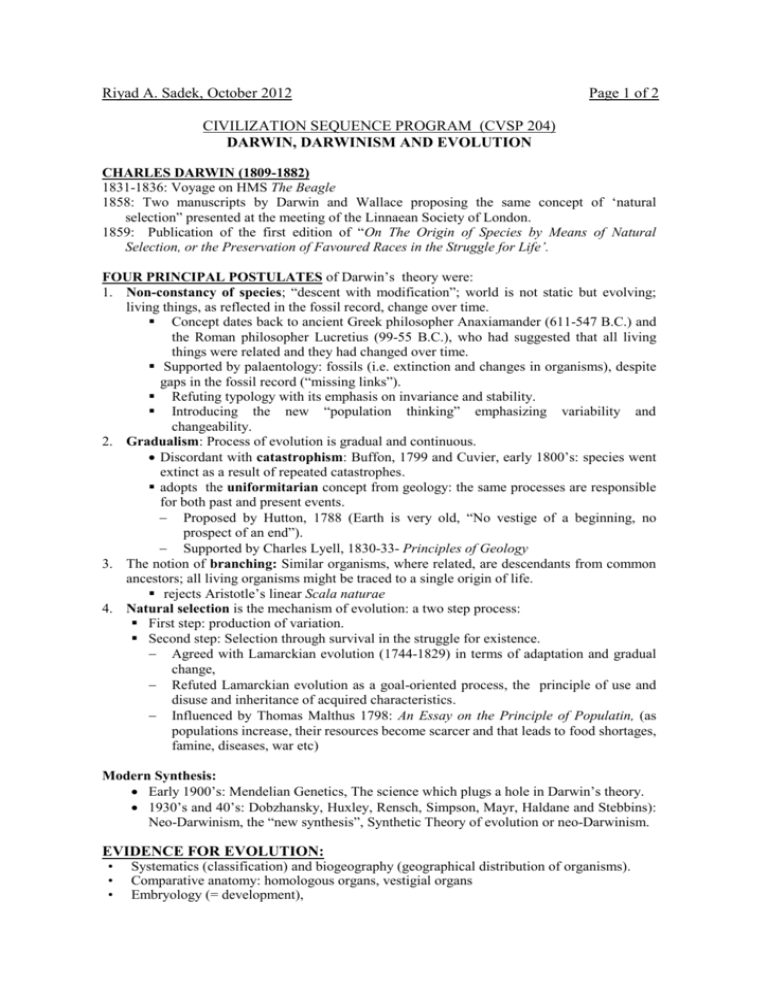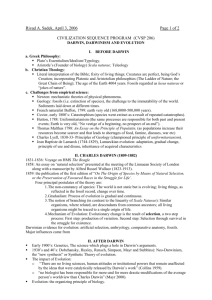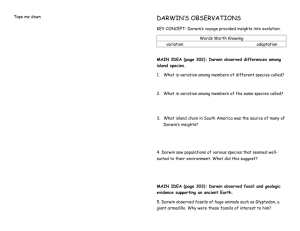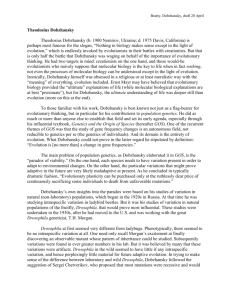CIVILIZATION SEQUENCE PROGRAM - American University of Beirut
advertisement

Riyad A. Sadek, October 2012 Page 1 of 2 CIVILIZATION SEQUENCE PROGRAM (CVSP 204) DARWIN, DARWINISM AND EVOLUTION CHARLES DARWIN (1809-1882) 1831-1836: Voyage on HMS The Beagle 1858: Two manuscripts by Darwin and Wallace proposing the same concept of ‘natural selection” presented at the meeting of the Linnaean Society of London. 1859: Publication of the first edition of “On The Origin of Species by Means of Natural Selection, or the Preservation of Favoured Races in the Struggle for Life’. FOUR PRINCIPAL POSTULATES of Darwin’s theory were: 1. Non-constancy of species; “descent with modification”; world is not static but evolving; living things, as reflected in the fossil record, change over time. Concept dates back to ancient Greek philosopher Anaxiamander (611-547 B.C.) and the Roman philosopher Lucretius (99-55 B.C.), who had suggested that all living things were related and they had changed over time. Supported by palaentology: fossils (i.e. extinction and changes in organisms), despite gaps in the fossil record (“missing links”). Refuting typology with its emphasis on invariance and stability. Introducing the new “population thinking” emphasizing variability and changeability. 2. Gradualism: Process of evolution is gradual and continuous. Discordant with catastrophism: Buffon, 1799 and Cuvier, early 1800’s: species went extinct as a result of repeated catastrophes. adopts the uniformitarian concept from geology: the same processes are responsible for both past and present events. Proposed by Hutton, 1788 (Earth is very old, “No vestige of a beginning, no prospect of an end”). Supported by Charles Lyell, 1830-33- Principles of Geology 3. The notion of branching: Similar organisms, where related, are descendants from common ancestors; all living organisms might be traced to a single origin of life. rejects Aristotle’s linear Scala naturae 4. Natural selection is the mechanism of evolution: a two step process: First step: production of variation. Second step: Selection through survival in the struggle for existence. Agreed with Lamarckian evolution (1744-1829) in terms of adaptation and gradual change, Refuted Lamarckian evolution as a goal-oriented process, the principle of use and disuse and inheritance of acquired characteristics. Influenced by Thomas Malthus 1798: An Essay on the Principle of Populatin, (as populations increase, their resources become scarcer and that leads to food shortages, famine, diseases, war etc) Modern Synthesis: Early 1900’s: Mendelian Genetics, The science which plugs a hole in Darwin’s theory. 1930’s and 40’s: Dobzhansky, Huxley, Rensch, Simpson, Mayr, Haldane and Stebbins): Neo-Darwinism, the “new synthesis”, Synthetic Theory of evolution or neo-Darwinism. EVIDENCE FOR EVOLUTION: • • • Systematics (classification) and biogeography (geographical distribution of organisms). Comparative anatomy: homologous organs, vestigial organs Embryology (= development), Riyad A. Sadek, October 2012 • • • Page 2 of 2 Palaeontology (= study of fossils), Genetics, ecology and behavior (including human behavior). Molecular & biochemical processes: Common to all types of organisms: Nucleotides, proteins, lipids & carbohydrates, DNA & RNA have the same constituents in all organisms. Genetic engineering: A protein from one organism could be synthesized in another if its DNA portion is incorporated into the host’s DNA. Observed evolutionary changes: evolution of antibiotic resistance in bacteria, resistance to pesticides, tolerance to pollutants etc. THE IMPACT OF EVOLUTIONARY THEORY: 1) Evolution: the organizing principle of biology “No biologist has been responsible for more …. drastic modifications of the average person’s worldview than Charles Darwin” (Mayr 2000). “Nothing in Biology makes sense except in the light of evolution.” (Dobzhansky 1973) 2) Philosophy of Biology: a new branch in the philosophy of science; “There are no living sciences, human attitudes or institutional powers that remain unaffected by the ideas that were catalytically released by Darwin’s work” (Collins 1959). 3) Rejecting all supernatural phenomena and causation. Conflicts with prevailing beliefs and faith: uneasy relationship with religious establishments; onslaught by “creationist science” and theories of ‘intelligent design” etc. “Design without designer” (Ayala, 2007) 4) Refuting determinism; accepting the universality of randomness and chance. Refuting teleology with its assertion of a “teleological force” driving towards ever greater perfection. (Aristotle’s teleology or “final cause”) 5) A new view of humanity. Anthropocentrism not reduced but enhanced (Man is indeed unique) Human Evolution: biological and cultural. 6) Providing a scientific (biological) foundation for ethics. Human cooperative and altruistic behaviors favored by natural selection, enhancing group survival; Selfishness implied in “social Darwinism” is not favored by natural selection. Cooperation and altruism shown in many animals and even other organisms. References/Suggested Readings Ayala, F.J., 2007 - Darwin’s greatest discovery: Design without designer. PNAS, 104(1):8567–8573 Collins, J., 1959 - Darwin’s impact on philosophy. Thought. 34:186-248. Dawkins, R., 2009 – The Greatest Show on Earth, The Evidence for Evolution. Transworld Publishers, London. Desmond, A. and J. Moore, 1992 – Darwin. Penguin Books, London. Dobzhansky, 1973 -Nothing in biology makes sense except in the light of evolution. American Biology Teacher 35:125-129. Mayr, E. 2000 – Darwin’s Influence on Modern thought. Scientific American 283:79-83. Renni, J. 2002- 15 Answers to creationist nonsense. Scientific American, July 2002: 78-85. Stix, G. 2009 - Darwin's Living Legacy. Scientific American. January 2009:38-43. Vuletic M.I. (Editor) – The Talk-Origins Archive: Exploring the evolution/creation controversy. http://www.talkorigins.org/origins/faqs-index.html#index_d University of Cambridge, 2002-2007-, The Complete Works of Charles Darwin Online. http://darwin-online.org.uk.










